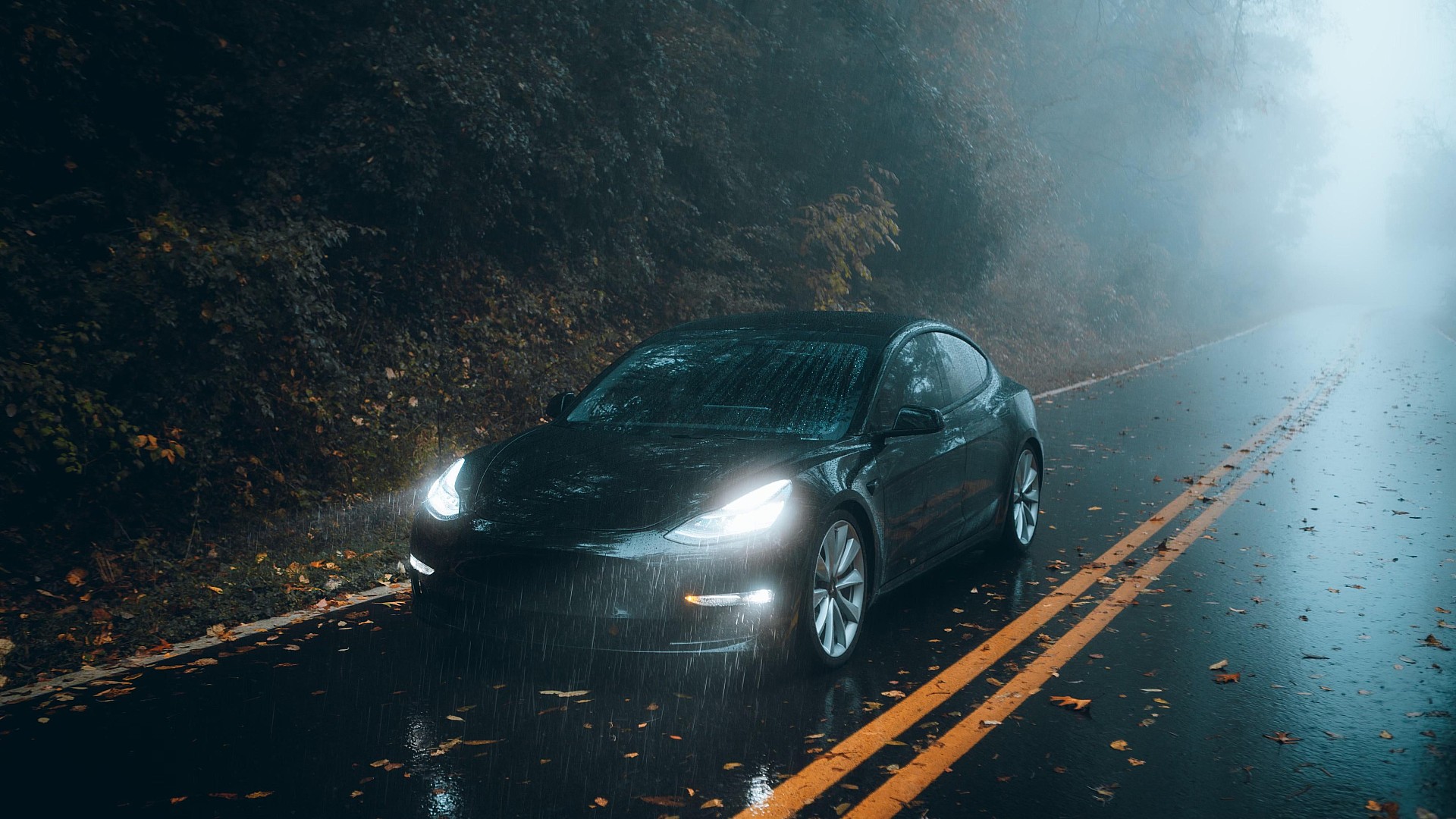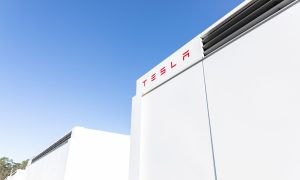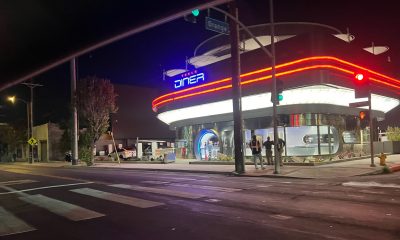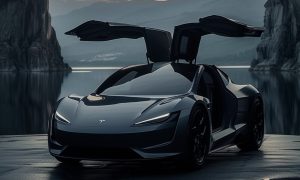Earlier this week, a report was released that revealed Tesla’s margins for the Model Y crossover in Shanghai. Guosen Securities, a Shenzen-based financial firm, found that Tesla holds a nearly 30% marginal rate on every unit. As the Model Y just recently began production and has become available for Chinese citizens to order, Tesla is already winning in 2021 as demand for the all-electric crossover is expected to be higher than the already-popular Model 3.
Peeking at the margins, it was reminiscent of the astronomical margins Tesla held early on with the Model 3 in Shanghai: 39.37%.
Breaking down the math for you all, an article I wrote earlier this week on the topic describes the price for manufacturing the vehicle and then compares it to the Made-in-Shanghai Model Y price for consumers.
“According to the Shenzhen, China-based financial firm, Tesla’s China Model Y only costs ¥237,930 (USD 36,852) to produce. However, its selling point gives Tesla a 29.4% gross margin with a price of ¥339,900 (USD 52,646.25). Due to the current demand for the all-electric crossover that just started being produced at Giga Shanghai, Tesla has plenty of room to come down. The company will likely do this after the demand is sustained for several months because the automaker did the same thing with the Model 3 after its initial gross margin was also turning Tesla a tasty profit.”
As a $TSLA investor, the margins made me feel great. Tesla is turning a sizeable profit on Model Y builds early on, and the margins are significantly higher than the automotive industry average, which sets around 8-10%. Holding 30% margins on any product, let alone a $52,000 car, is everything investors want. It means the company is pricing their vehicles to be competitive in a market where EVs are thriving, but it also means that Tesla is able to sell their car at a higher price while still being able to keep demand sustained.
This is a preview from our weekly newsletter. Each week I go ‘Beyond the News’ and handcraft a special edition that includes my thoughts on the biggest stories, why it matters, and how it could impact the future.
But it got me to thinking, does this mean that Tesla could technically drop the price of the Model Y in the future? The company would have the ability to still turn a profit and have a great margin that is higher than the auto industry average, but it would also create even more buzz for the car because it would be priced even lower than it already is. It is no secret that Tesla leads the industry in many ways, and a cheaper price tag for a Tesla EV would likely do a number of things that could be looked at positively: 1) Make a car more affordable, inching closer to price parity, and 2) Increase the number of vehicles on the road that dawn the Tesla T.
From an investor’s standpoint, it is tough to see an argument where lower margins are a good thing. We want competitive pricing, but why would we want it to be lower if the sales are there? Demand is healthy, there is no questioning that. Tesla showrooms in China were filled over the weekend with people looking to get a glimpse of the Model Y. Rumors have indicated that Tesla has already sold out of the car, showing that the vehicle was highly-anticipated and regardless of the price, people would buy.
Tesla showrooms get volunteer help amid Made-in-China Model Y launch
So what’s the big deal? Why would anyone want to decrease the cost of the cars?
From a consumer standpoint, lower prices are always better. Of course, wherever we can stand to save a few hundred, or even a couple thousand dollars on a car, we are going to do it. Of course, Tesla did away with price negotiations for cars (which is by far the most stressful part of buying a vehicle), so it’s not like owners can save money by wiggling down salespeople.
But looking at it from this point of view, Tesla has room to come down, and they’ve done it before. The Model 3, at the time of its release in China last year, was giving Tesla a massive 39.37% margin, and the price of the car was decreased five times in 2020. Based on estimations, Tesla could have margins around 25% on the Model 3 now, a nearly 15% decrease compared to the earliest projections.
There was wiggle room: Tesla did it once to reach the price point for government incentives, and others because production costs had gone down due to vertical integration. Grace Tao says there are probably no more price reductions in the future on the Model 3, but who knows what could happen.
The Model Y is a highly appealing vehicle due to its body style. Crossovers are some of the most popular cars on the market, and Tesla knows that. Elon Musk once said that the Y would overcome the 3 and be Tesla’s biggest seller. After the company released the Standard Range RWD variant on Thursday night, it is a good possibility to happen this year.
I think it is safe to assume that the Model Y will be a popular car in China just like the Model 3 has been. I think it is safe to assume that Tesla will really only battle with GM’s Wuling HongGuang Mini EV in that market this year. I also think it is safe to assume that Tesla isn’t going to adjust the price of the Model Y soon, considering the car just came out.
Moving forward, I think that consumers can assume that the Model Y will drop in price. Tesla will confirm that demand is healthy, and the company will continue to integrate parts of the car locally to save costs. This will bring the cost of the vehicle down anyway, so the price to the consumer will likely be adjusted accordingly.
There are advantages to keeping the margins high, especially with Tesla, because it is such a young company. Profitability will only increase, and Tesla will likely extend its consecutive quarter streak because of it. Tesla will make more money, sales will likely remain as demand is healthy, and shareholders will keep their smiles because the stock price will go up.
There are also advantages to cutting the cost: Tesla will move closer to parity with gas cars by adjusting the price, it will still have considerably higher margins than the auto industry average, and it will still make Tesla money, even if it is less.
I would love to hear your thoughts on the matter. I spoke to other investors, and they saw both sides as well, but of course, they felt the higher margins were more advantageous as their money is funneled into the company. I also feel that the high margins benefit me personally, but I would also like to see price decreases in the future to make the EVs more affordable.
A big thanks to our long-time supporters and new subscribers! Thank you.
I use this newsletter to share my thoughts on what is going on in the Tesla world. If you want to talk to me directly, you can email me or reach me on Twitter. I don’t bite, be sure to reach out!
News
Tesla Robotaxi has already surpassed Waymo in this key metric
Tesla Robotaxi has already overtaken Waymo in Austin in one key metric, but there’s still more work to do.

Tesla Robotaxi has already surpassed Waymo in one extremely important key metric: size of service area.
Tesla just expanded its service area in Austin on Monday morning, pushing the boundaries of its Robotaxi fleet in an interesting fashion with new capabilities to the north. Yes, we know what it looks like:
🚨 Tesla’s new Robotaxi geofence is…
Finish the sentence 🥸 pic.twitter.com/3bjhMqsRm5
— TESLARATI (@Teslarati) July 14, 2025
The expansion doubled Tesla Robotaxi’s potential travel locations, which now include the University of Texas at Austin, a school with over 53,000 students.
The doubling of the service area by Tesla has already made its travel area larger than Waymo’s, which launched driverless rides in October 2024. It became available to the public in March 2025.
According to Grok, the AI agent on X, Tesla Robotaxi’s current service area spans 42 square miles, which is five square miles larger than Waymo’s service area of 37 square miles.
Tesla Robotaxi (red) vs. Waymo geofence in Austin.
Much can be said about the shape… but the Robotaxi area is now ~3.9 mi² (10 km²) larger than Waymo’s!! pic.twitter.com/dVfh2ODxJC
— Robin (@xdNiBoR) July 14, 2025
The service area is one of the most important metrics in determining how much progress a self-driving ride-hailing service is making. Safety is the priority of any company operating a ride-hailing network, especially ones that are making it a point to use autonomy to deploy it.
However, these companies are essentially racing for a larger piece of the city or cities they are in. Waymo has expanded to several different regions around the United States, including Arizona and Los Angeles.
Tesla is attempting to do the same in the coming months as it has already filed paperwork in both California and Arizona to deploy its Robotaxi fleet in states across the U.S.
As the platform continues to show more prowess and accuracy in its operation, Tesla will begin to expand to new areas, eventually aiming for a global rollout of its self-driving service.
News
Tesla Megapacks arrive for massive battery replacing coal plant
Tesla Megapacks have started arriving on-site to the Stanwell Battery Project, just as Queensland prepares to wind down the Stanwell coal plant.
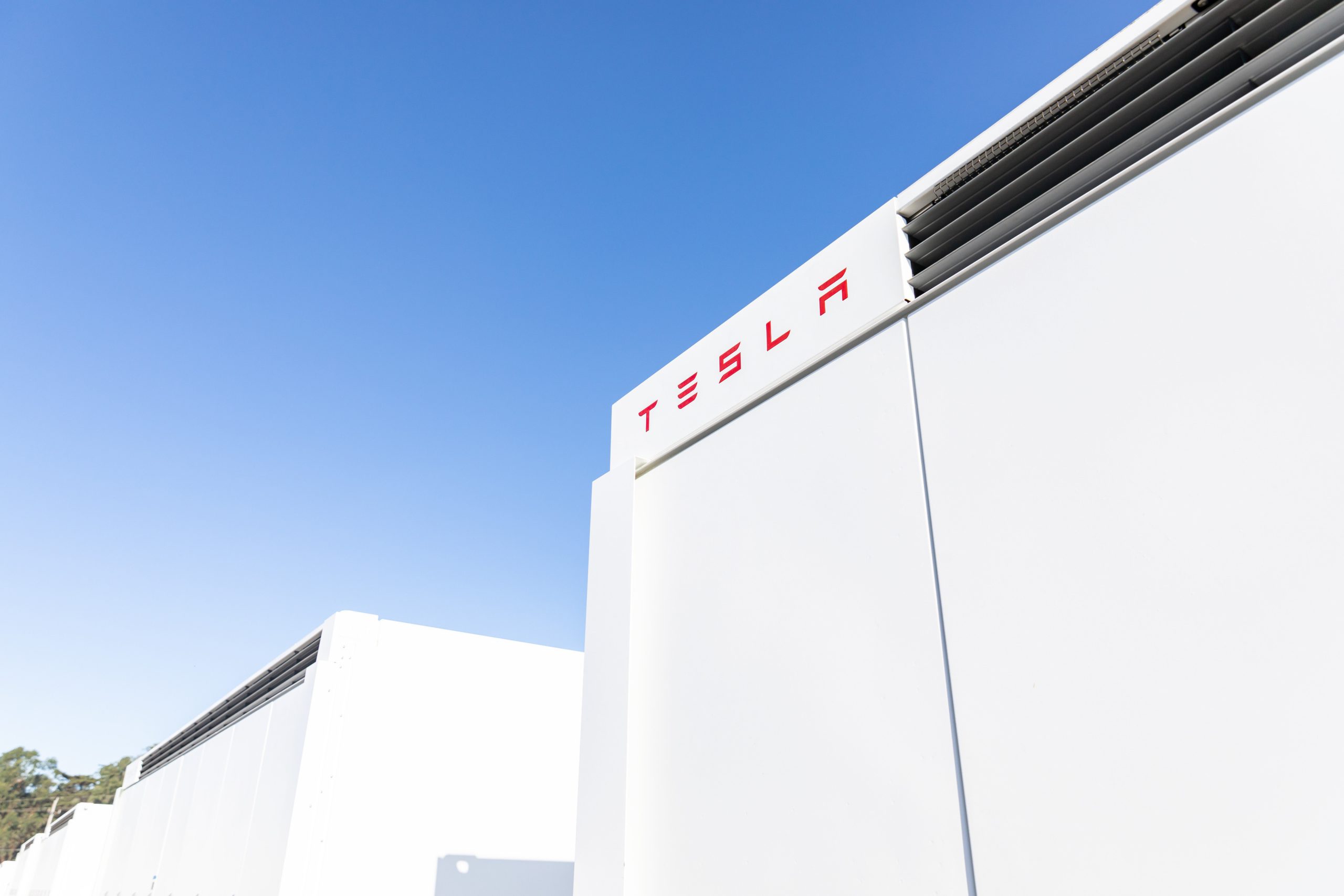
The first of over 300 Tesla Megapacks have arrived to the site of a massive battery energy storage system (BESS) being built in Australia, dubbed the Stanwell Battery Project after a coal plant it’s set to replace.
In a press release last week, the Stanwell Battery Project announced that the first Tesla Megapack 2XL units had arrived to the site, which is located outside of Rockhampton in Queensland, Australia. The project will eventually feature 324 Megapack units, set to arrive in the coming months, in order to support the 300MW/1,200MWh battery project.
“The Stanwell Battery is part of the diversification of our portfolio, to include cleaner and more flexible energy solutions,” said Angie Zahra, Stanwell Central Generation General Manager. “It is just one part of the 800 MW of battery energy storage capacity we have in our pipeline.
“Capable of discharging 300 MW of energy for up to four hours (1,200 MWh), our mega battery will be one of the largest in Queensland.”
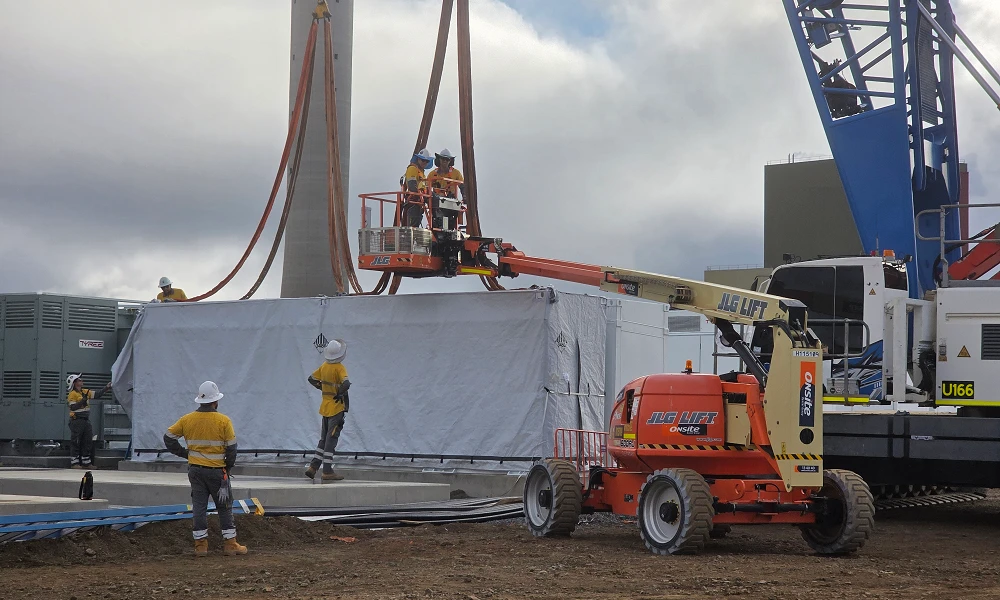
Credit: Stanwell
Did you know Tesla’s Lathrop facility churns out a Megapack every 68 minutes? That’s enough energy to power 3,600 homes for an hour per unit! ⚡️ pic.twitter.com/bG6fpHkB9O
— TESLARATI (@Teslarati) June 11, 2025
READ MORE ON TESLA MEGAPACKS: Tesla Lathrop Megafactory celebrates massive Megapack battery milestone
The state is working with government-owned company Yurika to facilitate construction, and the process is expected to create roughly 80 jobs. The project is expected to come fully online in May 2027, with initial commissioning of the Megapacks aiming for November 2025.
The Stanwell Battery is set to replace the nearby Stanwell coal generation plant, which the government is planning to wind down starting in 2026 as part of efforts to reach an 80 percent renewable energy generation ratio by 2035. Meanwhile, the government is also set to begin winding down the Tarong and Callide coal plants, while several other Megapack projects are being built or coming online. o ya
Tesla currently has two Megapack production facilities, located in Lathrop, California, in the U.S. and another that came online earlier this year in Shanghai, China. The Shanghai Megafactory shipped its first units to Australia in March, while both factories are expected to be capable of producing 10,000 Megapack units per year upon reaching volume production.
News
The Tesla Diner is basically finished—here’s what it looks like
The company first broke ground on the Diner, Drive-in, and Supercharger location in September 2023. Now, it has served one of its first internal customers.

Tesla has finally completed the construction of its highly anticipated Diner, Drive-in, and Supercharger in Los Angeles, and recent photos of the interior’s “retro-futuristic” style are making their way around the internet.
X user Brad Goldberg shared photos from the Tesla Diner site last Tuesday, depicting some of the Supercharger stalls, indoor and outdoor seating areas, multiple neon lights, and even an Optimus robot. Goldberg also noted that there had been a “flurry of activity on site” while he was snapping the photos last week, suggesting that the restaurant location could be getting close to opening.
The Tesla Diner also served one of its first internal customers in the past few days, as Elon Musk posted on X on early Monday morning that he had just finished up eating a meal at the site:
I just had dinner at the retro-futuristic Tesla diner and Supercharger.
Team did great work making it one of the coolest spots in LA!
The photos also show that the site is pretty much done, with some of them even showing vehicles charging at the charging stalls.
You can see some of the latest photos of the Tesla Diner below.
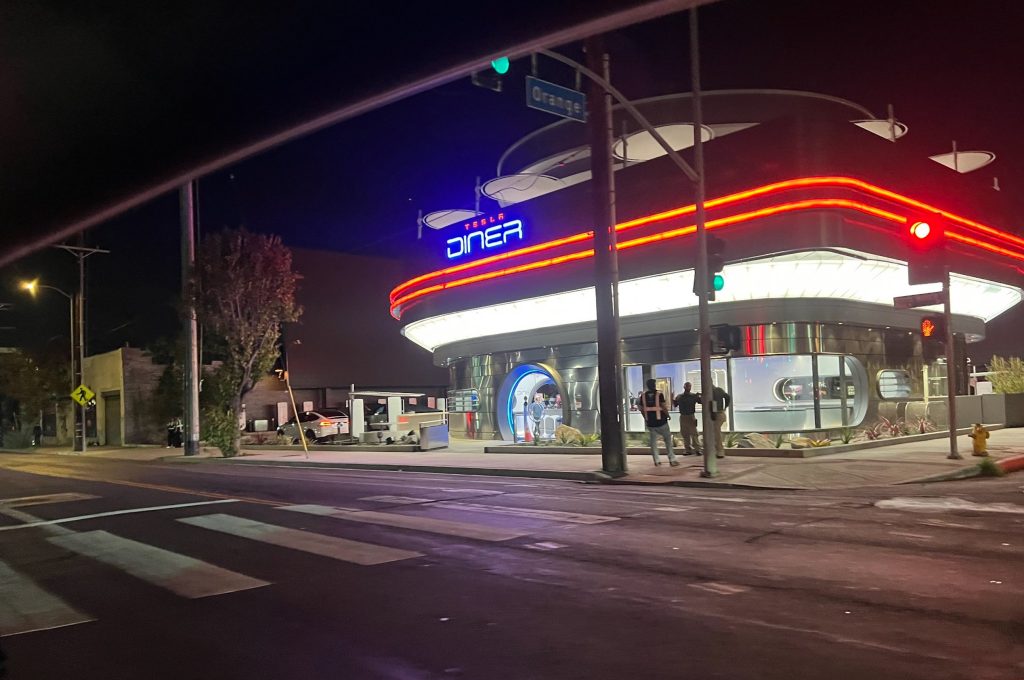
Credit: BradGoldbergMD | X
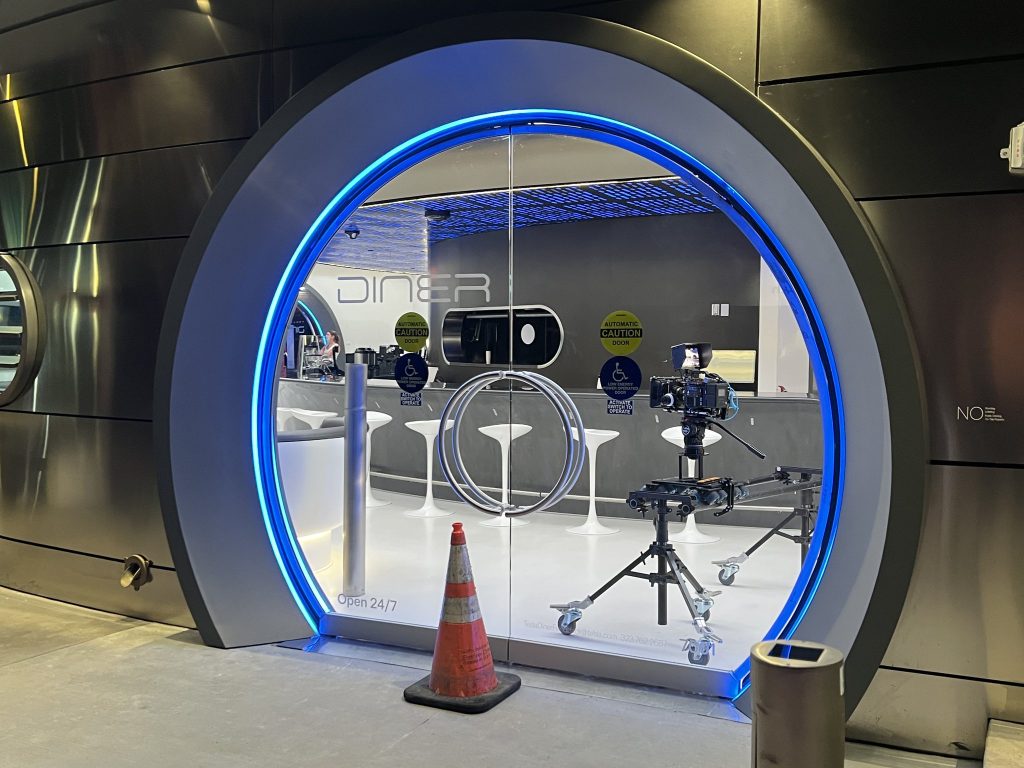
Credit: BradGoldbergMD | X
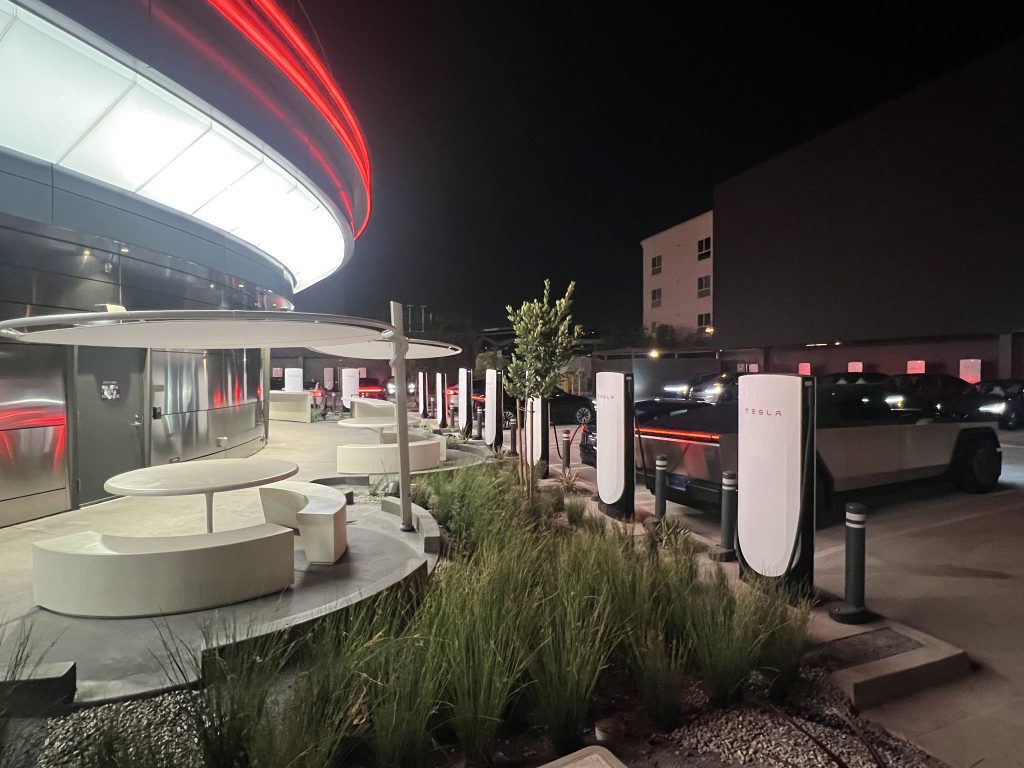
Credit: BradGoldbergMD | X
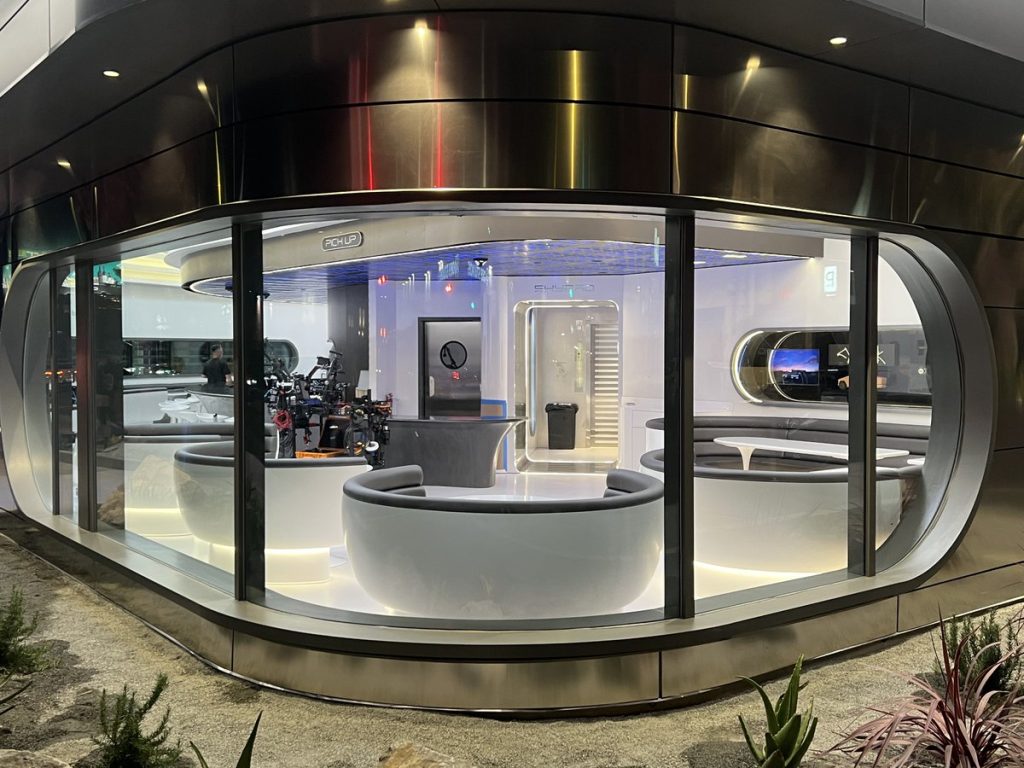
Credit: BradGoldbergMD | X
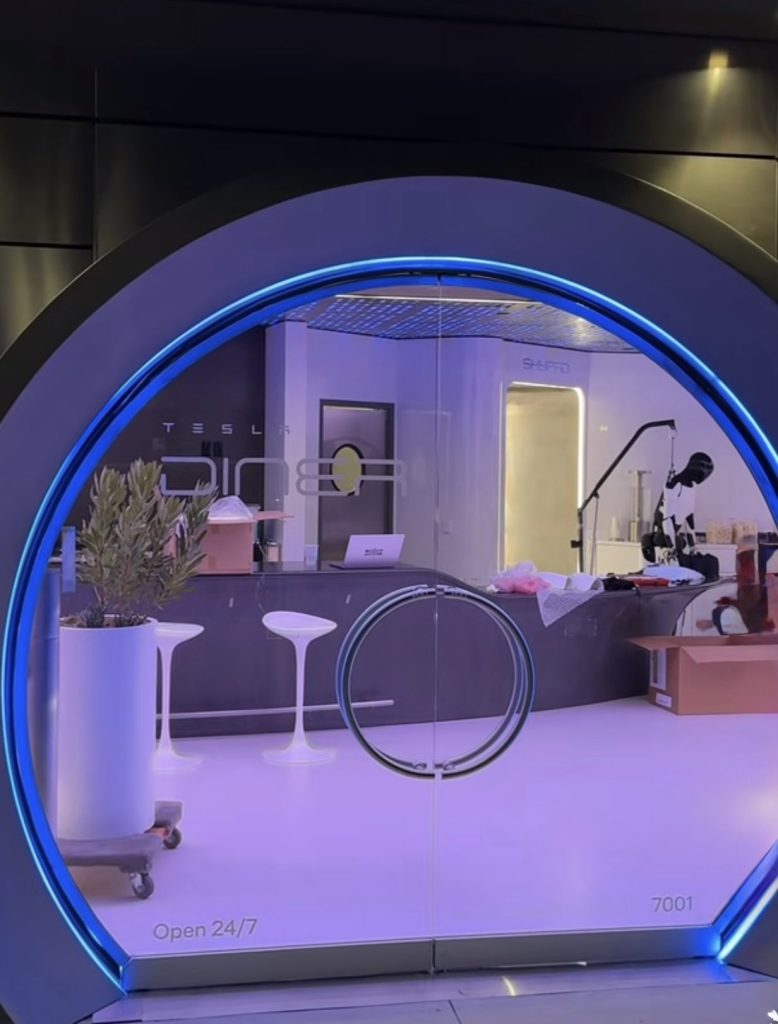
Credit: TeslaKing420 | X
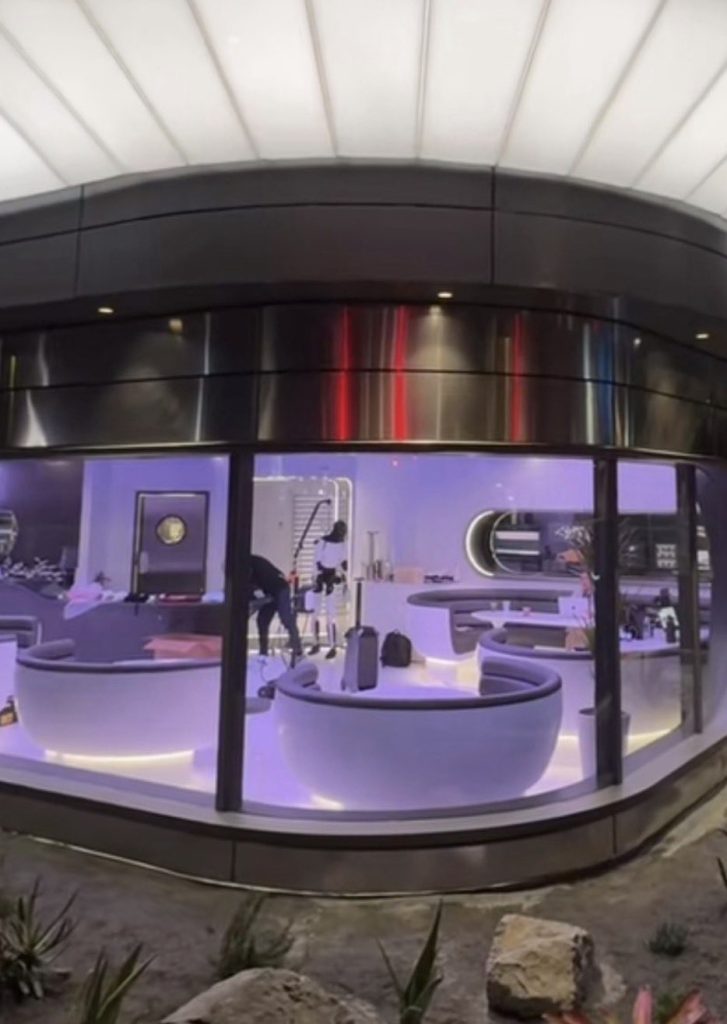
Credit: TeslaKing420 | X
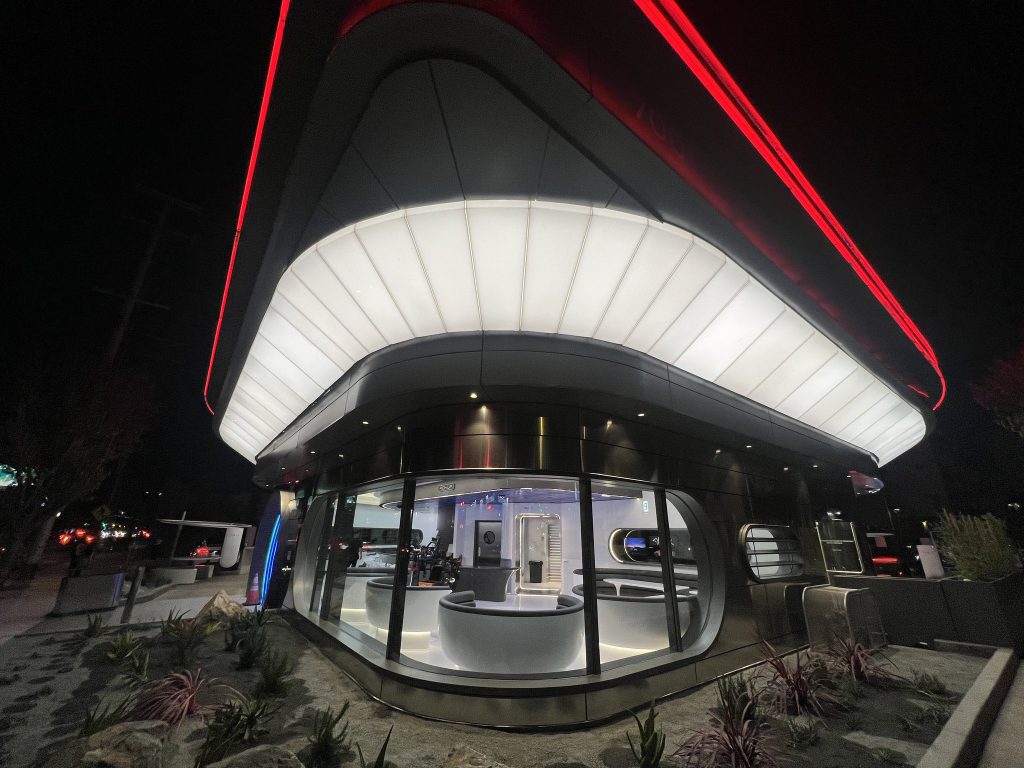
Credit: Brad Goldberg (via Sawyer Merritt on X)
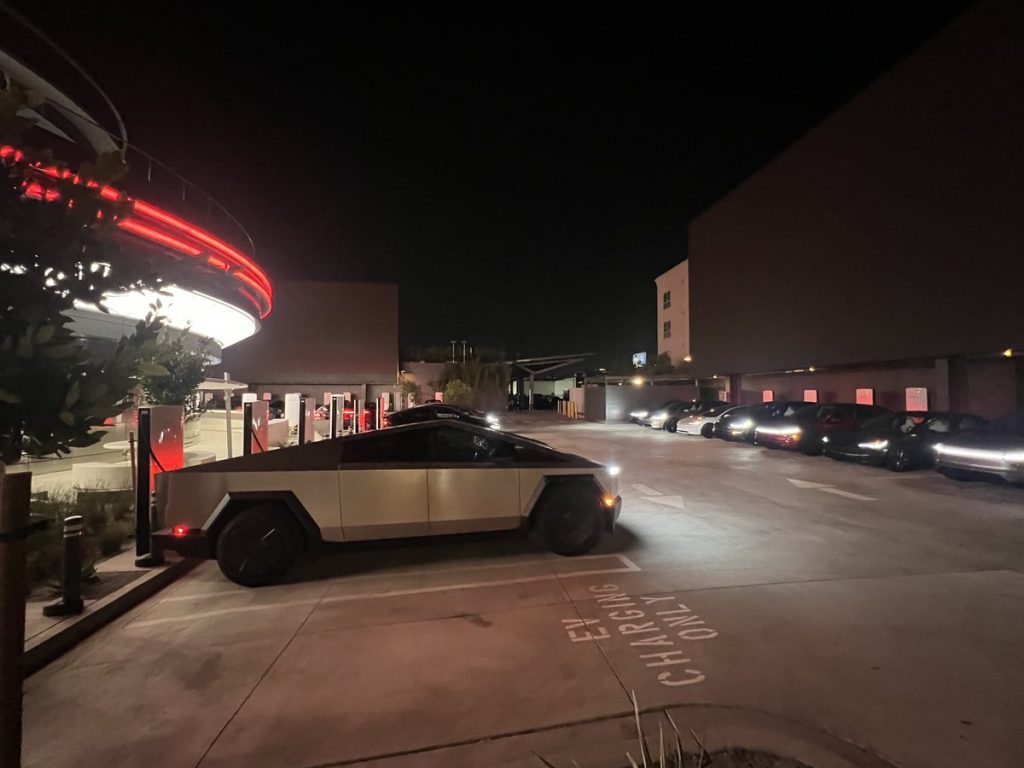
Credit: Brad Goldberg (via Sawyer Merritt on X)
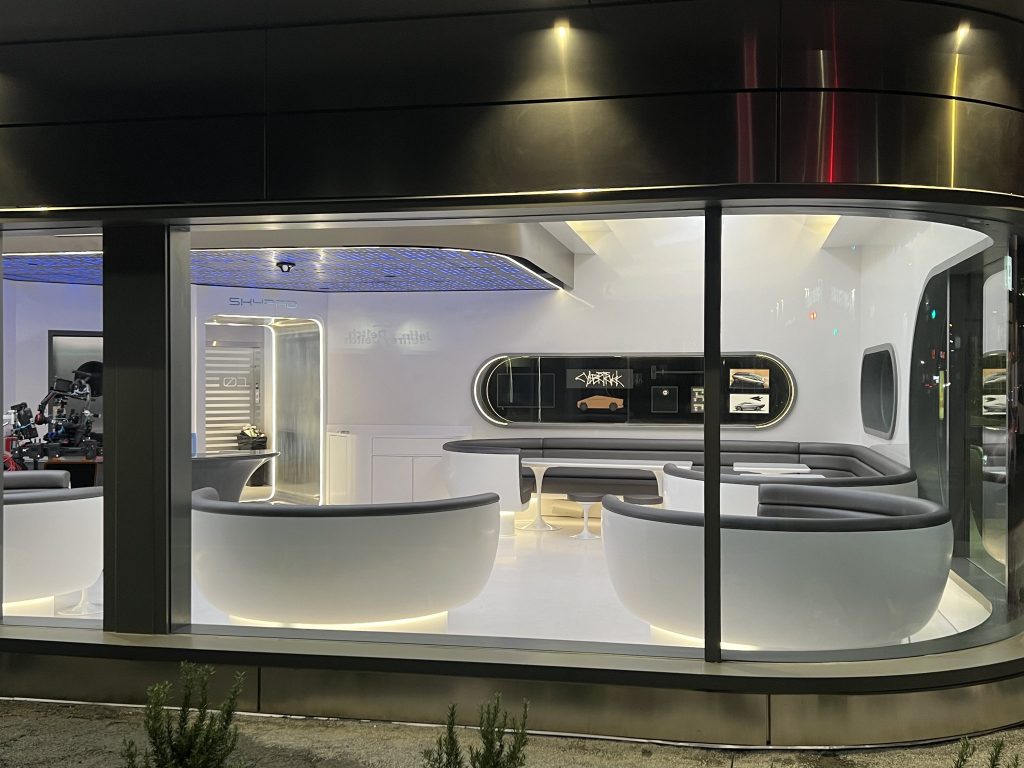
Credit: Brad Goldberg (via Sawyer Merritt on X)
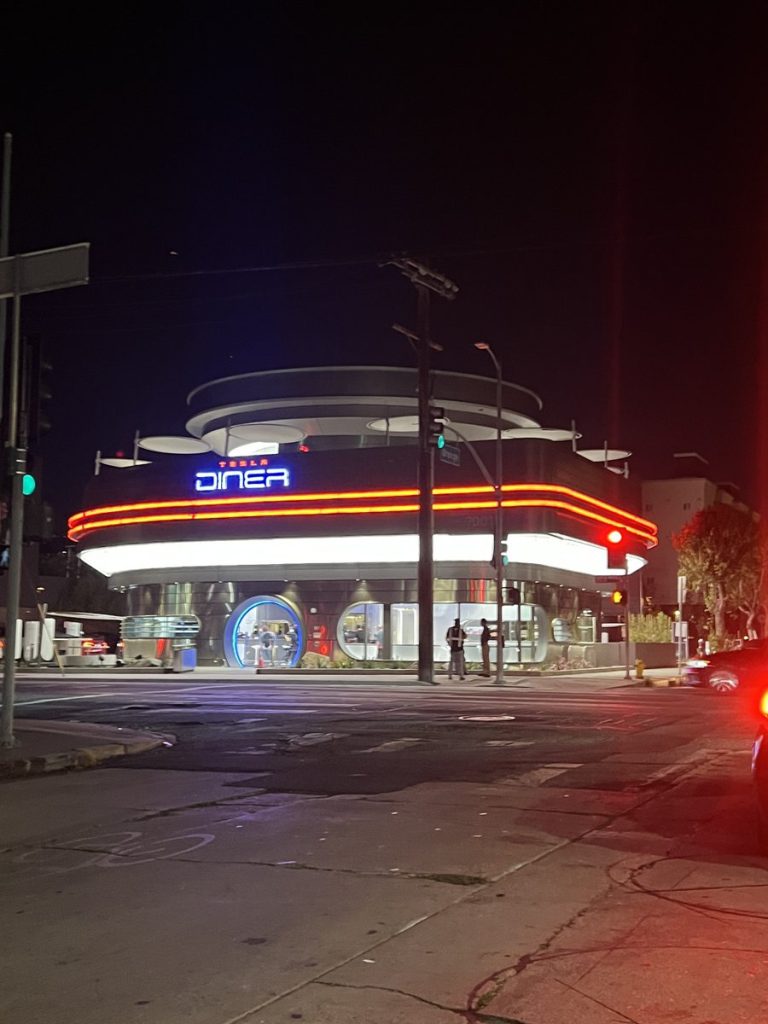
Credit: Brad Goldberg (via Sawyer Merritt on X)
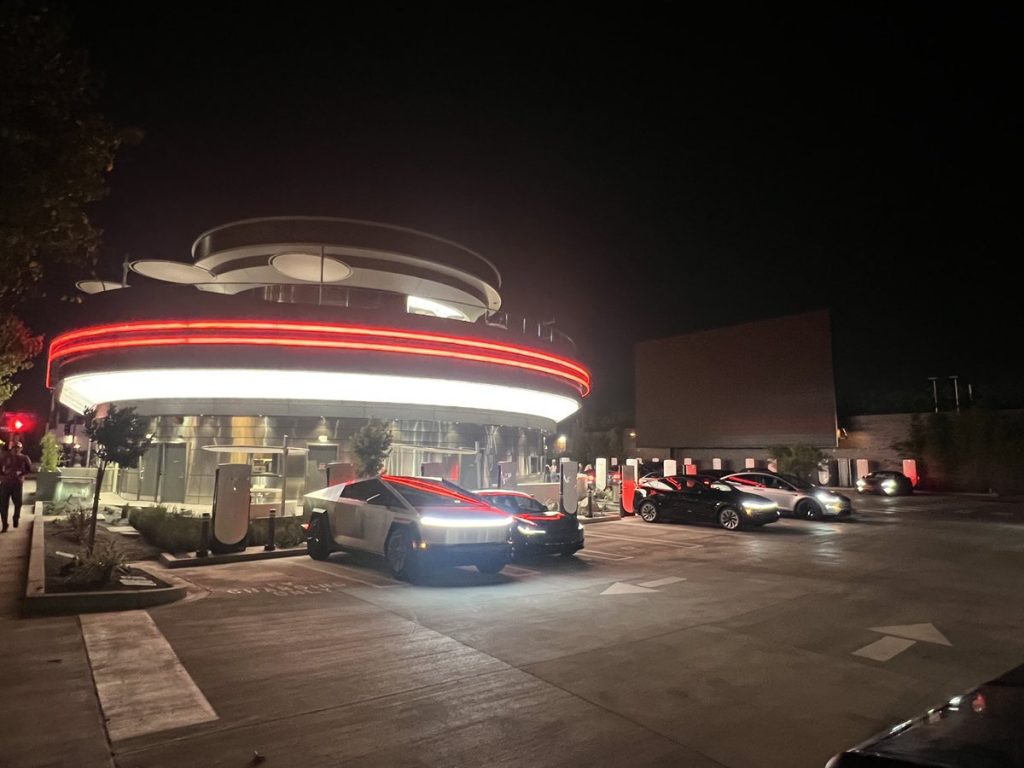
Credit: Brad Goldberg (via Sawyer Merritt on X)
READ MORE ON TESLA’S LA DINER: Tesla readies Drive-In Diner Supercharger for launch with app inclusion
When will the Tesla Diner open to external customers?
While it’s still not open to external customers yet, the news again suggests that the company could be close to an official opening date. Tesla first broke ground on the Diner in September 2023, after receiving a wave of building permit approvals throughout that year. Teslarati also covered much of the construction progress throughout last year, including when crews installed the first and second drive-in screens.
Located at 7001 West Santa Monica Boulevard, the idea was first discussed in 2018 by Musk and a few others on Twitter, featuring 1950s rock and roll, waiters on roller skates, and drive-in movie theater screens playing clips from some of history’s best movies. Notably, the photos of the front doors also show that the site will be open 24 hours a day, 7 days a week, whenever it does end up opening.
Tesla’s progress on Supercharger with diner, drive-in seen in aerial footage
-

 Elon Musk2 weeks ago
Elon Musk2 weeks agoTesla investors will be shocked by Jim Cramer’s latest assessment
-

 News2 days ago
News2 days agoTesla debuts hands-free Grok AI with update 2025.26: What you need to know
-

 Elon Musk4 days ago
Elon Musk4 days agoxAI launches Grok 4 with new $300/month SuperGrok Heavy subscription
-

 Elon Musk7 days ago
Elon Musk7 days agoElon Musk confirms Grok 4 launch on July 9 with livestream event
-

 News1 week ago
News1 week agoTesla Model 3 ranks as the safest new car in Europe for 2025, per Euro NCAP tests
-

 Elon Musk2 weeks ago
Elon Musk2 weeks agoxAI’s Memphis data center receives air permit despite community criticism
-

 News4 days ago
News4 days agoTesla begins Robotaxi certification push in Arizona: report
-

 Elon Musk2 weeks ago
Elon Musk2 weeks agoTesla scrambles after Musk sidekick exit, CEO takes over sales

